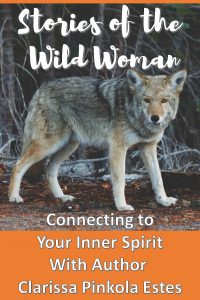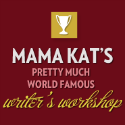Connecting to Books: Clarissa Pinkola Estes and the Wild Woman
 *This “wild woman” story make contain an affiliate link or two. If you make a purchase through my link, I may make a small commission. Don’t worry, I wouldn’t recommend a product I didn’t use and love myself.*
*This “wild woman” story make contain an affiliate link or two. If you make a purchase through my link, I may make a small commission. Don’t worry, I wouldn’t recommend a product I didn’t use and love myself.*
Earlier this week, we met folk artist Kacey Carneal. The bright colors, painted frames, and movement in her work connect with children and adults alike. She is an inspiration to many, including me. I met her nearly twenty-five years ago when I interviewed her for a local magazine. I got lost on the way to her house, and I was a few minutes late. Lucky for me, Kacey saw more than just a ditzy blond with a directional impairment. She saw a writer who needed to learn to take herself seriously. On a subsequent visit, she handed me Clarissa Pinkola Estes’ book Women Who Run with the Wolves: Myths and Stories of the Wild Woman Archetype. It was published in 1992 by Ballentine Books.
“You need to read this,” she said. “We all need to connect with our wild woman spirit. You need to find your instincts.”
Kacey was the first person to speak to me as though I were a genuine creative instead of a teenager playing around with a computer. For this reason, I took the book home and, for want of a better verb, devoured it. From then on, I saw myself differently.
Within a year, I was living alone on a goat farm for $300 per month in the middle of a Chesapeake Bay marsh. I was connecting with my inner wolf woman, my own instinctual nature. In reality, the old farm was all I could afford on a teacher’s salary, but I told myself I was reaching into the wild feminine soul. What I reached most of all were the mosquitoes droning around the marsh and feeding on the goats and me while I contemplated life and read Wolves. I believe the goats and I read the book three times that year. Goats aren’t big wolf fans, as it turns out. 
Symbols to Experiences
Estes takes all the traditional myths, fairy tales, and stories passed down in her own family and connects the symbols to experiences that women face in their lives. A Jungian analyst, Estes sees each story as a collection of archetypes. She considers herself a cantadora, or keeper of the old stories. She is a descendent of mesemondok, Hungarian story tellers, and cuentistas, Latina story tellers.
La Loba is a common thread—the wolf woman who sings life over the bones. When speaking about story- telling to Radiance magazine, Estes says, “In this tradition, a story is `holy,’ and it is used as medicine. The story is not told to lift you up, to make you feel better, or to entertain you, although all those things can be true. The story is meant to take the spirit into a descent to find something that is lost or missing and to bring it back to consciousness again.”
Singing Over the Bones
During my time at the goat farm, I, too, sang over bones that hadn’t really been missing, just not developed. I wrote questionable poetry, tried to paint, and made it through my first years of teaching. Back then, I completely identified with the soulfulness and drama resplendent in Wolves. Estes says, “A woman may crave to be near water, or be belly down, her face in the earth, smelling the wild smell.” I was all about the stars and the water, but back then, even I knew the mosquitoes would carry me away if I spent any time prostrate in my marsh. Now, sixteen years into parenthood, I don’t have to worry about goat poop, but time on my belly usually equates to a nap.
Back in my early twenties, I was all about howling my creativity into being like a true wild woman. I cried over lost relationships. I poured my dramatic little soul all over that old marsh. Estes says, “Tears are a river that take you somewhere. Tears lift your boat off the rocks, off dry ground, carrying it downriver to someplace better.” Back then, I was always trying to run, cry, or swim my way to “someplace better.” Now, I just want to sit quietly because I’ve finally realized that “someplace better” is right where I’m standing, whether it’s a goat farm overlooking the Chesapeake Bay or the parent pick-up line. That said, I’m not opposed to a good cry now and again, though.
Make the Space
One thing that still resonates, though, twenty-five years after my first reading of this book is that I have to make space to make things. Estes says, “The most important things is to hold on, hold out, for your creative life, for your solitude, for your time to be and do, for your very life.” None of us can single-handedly connect a divided world, but each of us can create a beautiful space around ourselves.
Estes’ dog-eared book still beautifies a space on my bookshelf. She, like Kacey Carneal and other soulful women who’ve led me along, inspires me to howl over the bones around me. As Estes says, “Ours is not the task of fixing the entire world at once, but of stretching out to mend the part of the world that is within our reach.” I hope that in stretching out on my own, I’ll find another wild woman stretching a paw to meet mine.








What a beautiful review. And how wonderful that it helped you to grow into the woman you are today!
So glad you liked it. This book was a huge deal for me in my early twenties. Twenty plus years later, some parts make me smile–most still ring true!
This book and the incredible words shared within have been my bible, for years. I think most of us share the wild woman spirit and run with the wolves at every opportunity. Wonderful review!
Thank you so much! I agree that we do share a part of that wild spirit, particularly those of us creative types. That said, I think all of us are creative if we just tap into that part of ourselves.
What an incredible book! So many amazing quotes that really sit with you and I love how relevant it is to all of us really!